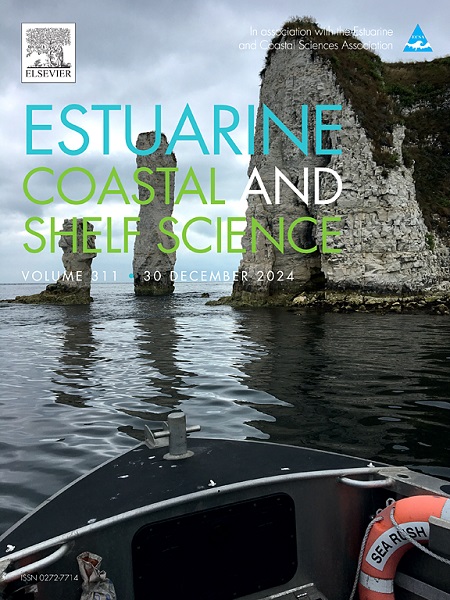巴基斯坦红树林和海岸带沉积物中的重金属污染及其在蟹类中的生物迁移
IF 2.6
3区 地球科学
Q1 MARINE & FRESHWATER BIOLOGY
引用次数: 0
摘要
本研究旨在评估巴基斯坦红树林和沿海地区沉积物和底栖蟹中重金属(HMs)的分布、污染和来源。HMs (Cu, Zn, Cr, Pb, Co, Ni和Cd)的存在是显著的(p <;0.05)。根据沉积物质量指南,所有地点被划分为中低优先级,对底栖动物产生不利生物影响的概率为25%。以7种底栖蟹为研究对象,对其HM的生物积累特征进行了分析,发现HM分布具有生境特异性和物种特异性。HM浓度指标(HMCI)对各物种表现出不同的行为。以金属污染指数(MPI)衡量蟹类总体HM负担,所有蟹类均呈现MPI值>;1.0. 招潮蟹(Austruca sindensis)和招潮蟹(A. iranica)表现出最高的MPI值,表明其应对各种HMs的能力。大多数金属(Cu、Zn、Co、Pb和Cd)表现出较高的沉积-生物群积累因子(SBAF >1.0),表明与周围环境相比,螃蟹中存在HMs。主成分分析(PCA)区分了沉积物和螃蟹中的HMs,并表明长期的人为事件聚集了沿海沉积物中的HMs,可能被纳入底栖生物食物链。结果表明,该蟹类是HMs的高效蓄积者,是污染环境中HMCI的潜在候选者。本文章由计算机程序翻译,如有差异,请以英文原文为准。
Heavy metal pollution in sediments and its Biotransference in crabs from mangrove and coastal zones of Pakistan
This study endeavored to assess distributions, contamination, and sources of heavy metals (HMs) in sediments and benthic crabs in mangrove and coastal zones of Pakistan. The presence of HMs (Cu, Zn, Cr, Pb, Co, Ni, and Cd) was significant (p < 0.05) in sediments among the study sites.According to sediment quality guidelines, all sites were categorized as medium-low priority with a 25 % probability of having adverse biological effects on benthic fauna. Seven benthic crab species were analyzed to investigate HM bioaccumulation, which presented habitat-specificity and species-specific variations in HM profiles. Each species exhibited different behavior as expressed by the HM concentration indicator (HMCI). The overall HM burden in crabs was considered by the metal pollution index (MPI), and all crabs showed an MPI value > 1.0. Fiddler crabs (Austruca sindensis and A. iranica) exhibited the highest MPI values indicating their ability to cope with various HMs. Most of the metals (Cu, Zn, Co, Pb, and Cd) showed a high sediment-biota accumulation factor (SBAF >1.0) that signified the prevalence of HMs in crabs as compared with their surroundings. Principal component analysis (PCA) discriminated between HMs in sediments and crabs and suggested that long-standing anthropogenic events aggregated HMs in coastal sediments, potentially incorporated into the benthic food chain. The crab species was revealed as an efficient accumulator of HMs and acted as a potential candidate for HMCI in the contaminated environment.
求助全文
通过发布文献求助,成功后即可免费获取论文全文。
去求助
来源期刊
CiteScore
5.60
自引率
7.10%
发文量
374
审稿时长
9 months
期刊介绍:
Estuarine, Coastal and Shelf Science is an international multidisciplinary journal devoted to the analysis of saline water phenomena ranging from the outer edge of the continental shelf to the upper limits of the tidal zone. The journal provides a unique forum, unifying the multidisciplinary approaches to the study of the oceanography of estuaries, coastal zones, and continental shelf seas. It features original research papers, review papers and short communications treating such disciplines as zoology, botany, geology, sedimentology, physical oceanography.

 求助内容:
求助内容: 应助结果提醒方式:
应助结果提醒方式:


